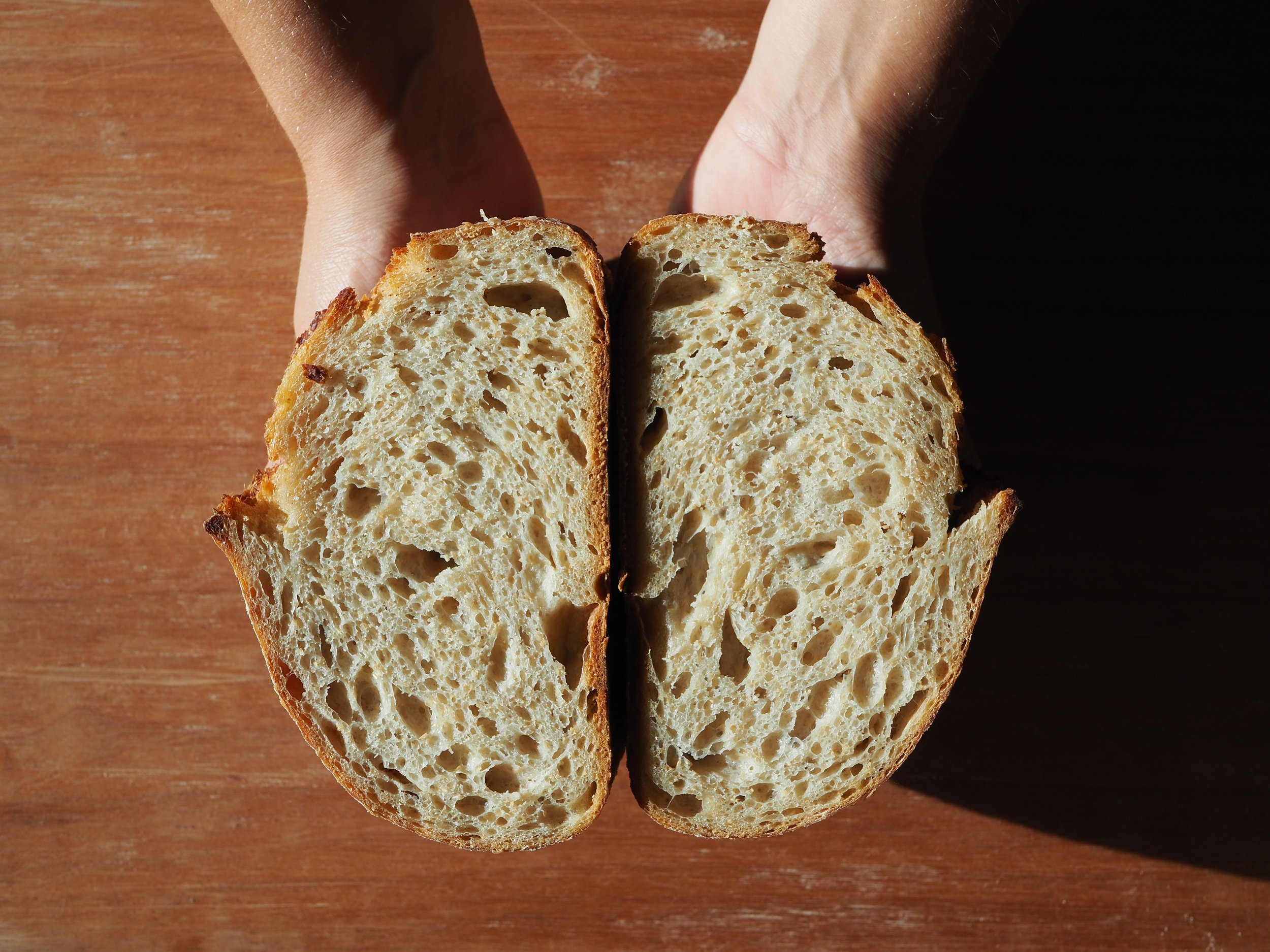
sourdough troubleshooting
If your loaf hasn’t come out as you wished, here are some FAQs and some tips that can help you to troubleshoot and work out what’s going on with your loaf of bread and /or starter
I can never get an ear on my loaf. How do you do it?
There’s a few factors involved in getting an ear (aka a little bit of the crust that sticks up kind of like an ear, where you cut it, see the picture below for an example). First, you need a sharp razor blade to score the bread with. You simply score the bread at a slight angle (this video can help to visualise the process). Secondly, your bread needs to be well developed. If it’s overproved you probably wont get an ear. Keep reading for more tips on how to get the proofing of your loaf just right.
A loaf with an ear
My dough is very sticky but yours looks so smooth, why?
My number one tip to make the dough less sticky is just using wet hands, and a slightly wet benchtop.
Aside from that, the flour you use can make a difference. Rye flour, for example tends to be sticker than baker’s flour. Even if you’re following the same recipe, different flours absorb water quite differently (even the same kind of flour coming from different parts of the world can behave quite differently). If you’re finding your dough is just way too wet or too dry, don’t be afraid to adjust the recipe a little to make it a more manageable consistency.
Another thing that makes the dough smooth is salt. If you’ve reduced the salt in the recipe, the dough is likely to be more stick.
Good proofing also makes your dough easier to handle. If you’re trying to shape your dough and it’s very sticky, it’s quite likely it’s had a bit too much time at room temperature.
My loaf is very dense and didn’t rise.
Most likely when this happens, it’s not you - it’s your starter. If your loaf is dense, has uneven holes and a gummy texture, most likely there wasn’t enough active wild yeast in your starter to make the bread develop and rise during baking. This can be the case even if your starter seems really happy and bubbly. Read the tips below to help with strengthening your starter.
Alternatively, it could be that your room is too cold and it’s stopping the fermentation process from happening. To fix this, try keeping your dough in the oven with just the light turned on while it’s developing. Ideally the dough should be between 20-25 C.
Your loaf might look like this if your starter isn’t strong enough yet
My loaf is flat, I can’t get an ear and the inside looks kind of like honeycomb.
This means your loaf is overproved i.e. it had too much time to develop and now can’t rise like it normally would. This is a good problem to have because it’s easy to solve: just give your dough a bit less time at room temperature - try an hour or two less and see how it turns out.
Above are two examples of what overproved bread looks like on the inside.
For comparison: the inside of a loaf that was (in my opinion) very nicely proved.
My starter isn’t strong enough, how can I strengthen it?
If you’re having issues with your loaves not being light and fluffy, this would be my first focus when trying to fix that problem. There are a few things you can do to make the starter stronger:
Keep it at room temperature (ideally 20-25C) and feed it twice a day
Discard more than you usually would when you feed it, e.g. leave only about 1 tsp in the jar and then feed with 50g flour and 50g water
Try changing flours, sometimes just a different brand can make a difference
Try feeding with rye or wholemeal flour, or a combination of baker’s and one of those
Avoid using bleached flour
If it’s cold, feed with warm water
If you are worried that your starter isn’t ready yet but you really want to make a loaf right away, you can add a little yeast (1-2g) to your dough mix and follow the recipe as per normal. That small amount of yeast will help to support the starter in developing your dough.
My starter has water on top. Is that bad?
If your starter has separated and/or has water on top, this is called ‘hooch’ and it’s nothing to be concerned about. All this means is that your starter is hungry so you should feed it again. You can tip the hooch off or you can stir it back in. If you stir it in, it will make your starter more sour.
My starter is mouldy. What should I do?
Generally mould is the only time to give up on your starter. I’ve also heard of baker’s bringing back mouldy ones by just taking a tiny uninfected bit, but personally if I found mould, I would just start again.
To avoid mould:
Sterilise your starter jar
Use only clean utensils when feeding the starter
Try changing flours
I forgot to feed my starter for a while, will it be okay?
As long as it doesn’t have mould, it should be fine. If it’s been at the back of the fridge for a while, it will be fine. Smell is also a very good indicator of whether it is okay or not. To make it happy again, take about 1 tsp and put it in a clean fresh jar, then feed it with 50g of water and 50g of flour and repeat twice a day for a day or two until it bubbles and rises predictably.
The consistency of my starter is too watery, what should I do?
Just add some more flour to the mixture until it gets to the consistency you’d like it to be.
It’s really warm where I am and I can’t keep up with the feeding schedule, my starter keeps going watery.
If it’s warm, especially if it’s humid, the wild yeast will be very active and eat their food [the flour] very quickly, meaning they’ll get hungry more quickly. To slow them down you can feed them a different ratio: take 1tsp of starter and feed it with 25g of water and 50g of flour.
You can also keep the starter in the fridge and just feed it when you want to make bread. This is what I do with mine and I feed it and use it about once a week.
It’s really cold where I am, how can I keep the starter warm so that it rises?
You can keep your starter in the oven or microwave with a cup of warm water next to it. This creates a kind of proofing box for your starter. You can also feed it with warm water. Sometimes I turn my oven on for about 1 minute and then turn it off and put the starter in, so it’s just warm inside. Another warm place to put the starter can be on top of the fridge.
I’ve been feeding my starter for weeks and it’s not rising, there are just a few bubbles.
Try changing flours, feeding it twice a day, add a little honey when you feed it, use part rye flour if you can find it, and make sure you’re keeping it somewhere between 20-25C. And most importantly, don’t give up! Bubbles are a good sign that something is happening. If it’s got quite a few bubbles but hasn’t risen too much, you could still try and bake a loaf with it and see, it might turn out just fine! My starter doesn’t always rise a lot and it still works.
How do I shape a loaf?
I made this video to help you shape your loaf into an oval shape.
What about gluten free sourdough?
Here’s a recipe I posted a while back. There are more recipes inside Live Laugh Loaf and there’s a step by step guide to making gluten free sourdough starter too (but shortly summarised you can follow the same steps as for regular starter, just add a little extra water so that you get the right consistency).
I hope the answer to your question was here!
It also makes a difference which recipe you’re using to make your bread.
I can give some general information about sourdough, but the best way I can help you is if you follow my recipes (for bread and starter) step by step, which you’ll find inside my book Live Laugh Loaf.
And there’s a lot of extra info on starter and the sourdough process inside.






